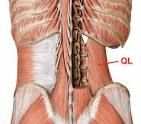Muscle Highlight: The Quadratus Lumborum
You may not have heard of it by name, but if you've ever experienced nagging lower back pain, your quadratus lumborum (QL) muscle might be the culprit. This deep core muscle plays a key role in your daily movement—and when it's tight, weak, or overworked, it can cause discomfort that’s hard to ignore.
Let’s take a look at what the QL muscle is, what it does for you, and why you might want to have it massaged. Read to the end for some bonus yoga stretches for this muscle.
Where Is the Quadratus Lumborum?
The quadratus lumborum is a deep muscle located on both sides of your lower back. It attaches from the top of the pelvis to the 12th rib and the transverse processes of the lumbar spine (L1–L4).
In simpler terms, it connects your hips to your spine and lower ribs, helping to stabilize your lower back and support upright posture.

What does the QL do?
The QL might be small, but it’s mighty when it comes to movement and stability. It has several important functions:
- Lateral Flexion: Bends the spine to the side (like in bananaasana).
- Spinal Stabilization: Helps maintain upright posture and supports the spine during movement.
- Assists Breathing: Anchors the 12th rib during deep inhalation, especially during forced breathing such as some pranayama practices.
- Pelvic Elevation: Raises one side of the pelvis, which is important for walking and weight shifts.
Because the QL works constantly to stabilize the body and support everyday activities, it can easily become tight, fatigued, or strained.
Why would you get your QL massaged?

A tight or overworked QL can contribute to a wide range of discomfort, including:
- Lower back pain, especially on one side
- Hip imbalance or pelvic tilt
- Pain when standing up or sitting for long periods
- Difficulty with bending or twisting motions
Massage therapy targeting the QL can help:
- Release chronic tension
- Improve range of motion in the lower back and hips
- Relieve referred pain (especially to the hip, glutes, or even the ribs)
- Enhance posture and breathing capacity
Because the QL lies deep beneath other back muscles and fascia, skilled, gentle, and precise massage techniques are often needed to access and release it effectively.
How can you stretch your QL?

Stretching the QL can bring immense relief, especially when combined with massage or after long periods of sitting. Here are a few accessible stretches:
Windshield wiper
- Lie on your stomach with your knees bent.
- Gently windshield wiper your feet from side to side.
Standing Side Stretch
- Stand with feet hip-width apart.
- Reach one arm up and over your head while leaning gently to the opposite side.
- Keep your hips steady and avoid twisting.
- Hold the stretch, then switch sides.
Child’s Pose with Side Bend
- From a kneeling position, sit your hips back onto your heels, arms extended forward.
- Walk both hands over to one side, feeling a stretch along the opposite side of your lower back.
- Hold for several breaths and repeat on the other side.
Tip: Move slowly and mindfully. If you feel pinching or sharp pain, back off the stretch.
The Bottom Line
Your quadratus lumborum may be out of sight, but it should never be out of mind. Whether you're managing lower back pain, working on core stability, or simply seeking more comfort in your daily movement, understanding and caring for this key muscle is essential.
Massage and stretching can work hand-in-hand to restore balance, ease discomfort, and support a more upright, mobile you.
Want to experience what a QL release feels like? Book a massage session and let’s give this hardworking muscle the attention it deserves!
On the Blog



